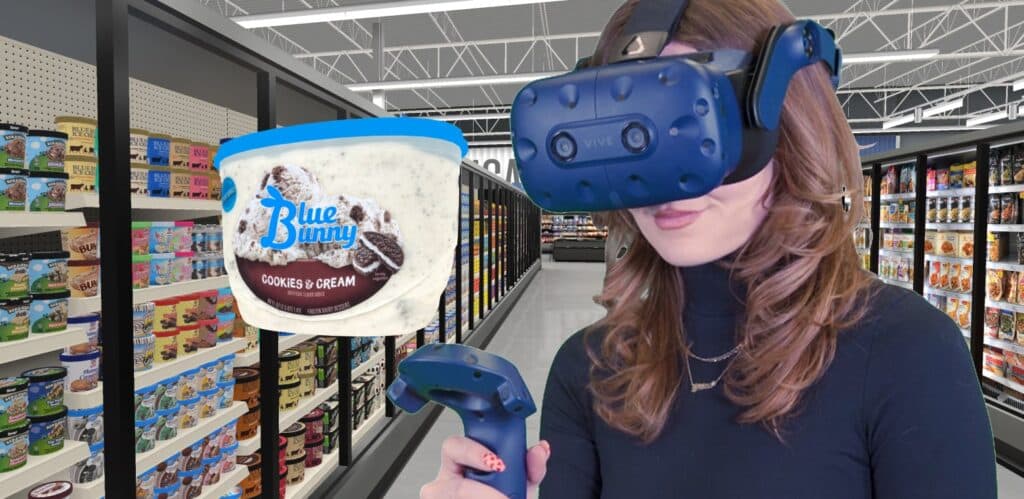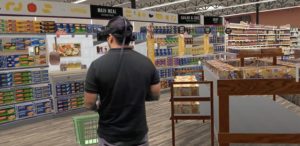Ice Cream Category Leverages VR Innovation for Sales Growth

Learn about new virtual reality retail planning and research solutions aimed to assist ice cream industry growth amid recent sales decline.
The ice cream industry has faced a noticeable decline in unit sales since the pandemic, as reported by Kroger’s retail data science company 84.51˚. Their ice cream industry analysis showcased inflation driving a modest 1% increase in ice cream sales revenue for the 52 weeks ending June 8. With bulk purchases, such as six-quart-sized ice cream containers, surging by 35% over the last year.
This data suggests the latest pivot in consumer preferences as fewer people indulge in treats at home and if so, lean towards bulk purchasing. Although some frozen dessert industry products are holding a promising sales outlook, most are looking to improve their performance. In order to achieve these goals, innovation focused ice cream manufacturers are turning to emerging technologies like Virtual Reality (VR) to accelerate their market research process.
While traditional market analysis provides insights into current ice cream industry trends and growth rates, it often lags behind the rapidly evolving consumer landscape. Understanding whether consumers prefer something with health benefits or indulging in regular ice cream as a treat has become more complex. This is where VR solutions come into play, offering a cutting-edge approach to the ice cream innovation process. Providing a market research and retail planning method that can keep pace with these changes.

Virtual Reality as a Catalyst for Future of Ice Cream Industry Growth
Virtual reality retail planning and shopper research are revolutionizing how manufacturers understand and respond to ice cream market trends. By leveraging VR, companies can gain detailed insights into regional consumption patterns, the performance of different flavors, and the preferences of health-conscious consumers—all in a cost-effective and time-efficient manner.
3D Ice Cream Assortment Planning
Advanced 3D models of frozen treats allow ice cream brands like Ben & Jerry’s and Häagen-Dazs to ideate and test new freezer aisle planograms in a virtual space. This enables them to experiment with various assortment organizations and product placements quickly, without the constraints of physical testing. VR research allows for limitless variants to be tested, helping companies optimize their ice cream product offerings and shelf layouts to better meet consumer demand.

Immersive Virtual Shopper Research
Virtual research can be conducted in two primary ways: through interactive navigation on a computer or via immersive, life-size shopping experiences. These methods provide deep insights through data collection and analytics, including eye-tracking technology, which can help predict the performance of both traditional dairy products and dairy-free alternatives.
These digital experiences offer a comprehensive view of consumer preferences. Whether you're testing the consumption of ice cream, the appeal of different flavored ice creams, or comparing vegan ice cream to traditional ice cream options, this technology provides valuable insights across the entire frozen dessert market. Additionally, the global ice cream market can be assessed through online studies, making it easier for brands to understand and respond to regional variations in consumer behavior.

Conclusion
As the ice cream industry navigates a changing market, VR offers a powerful tool for staying ahead of trends. By embracing virtual research methods, manufacturers can not only address current sales declines but also uncover new opportunities for growth in an increasingly competitive landscape.
Subscribe to our newsletter
Get our blogs and the latest retail news delivered to your inbox monthly.
Recent Posts
5 Holiday Shopping Predictions & Recommendations for 2021
The pandemic greatly influenced celebrations and holiday shopping in 2020, but with normalcy on the horizon there are different 2021 holiday predictions that retailers should consider. Last year, the Covid-19 pandemic led to a decrease in holiday social gatherings. Although there were less family holiday celebrations and religious services, traditions such as decorating, gifts and…
Eye-Tracking VR Technology is Changing the Retail Industry
Retailers use virtual reality to conduct eye tracking consumer research that uncovers accurate shopper insights. The pandemic and rapid digital transformation in retail is pressuring brands to innovate and adapt their shopping experiences based on changing consumer behaviors. In order to quickly collect and understand consumer insights, many organizations have turned to virtual reality. Virtual…
7 Retail Industry Trends to Watch Out for in 2021
Today, the rapid advancements in technology have led to almost every facet of our lives shifting online, catering to a population that is more adaptive to the current times. The retail industry is no exception. The current world situation has vastly impacted retail industry trends in 2021, with an increasing number of people resorting to…


